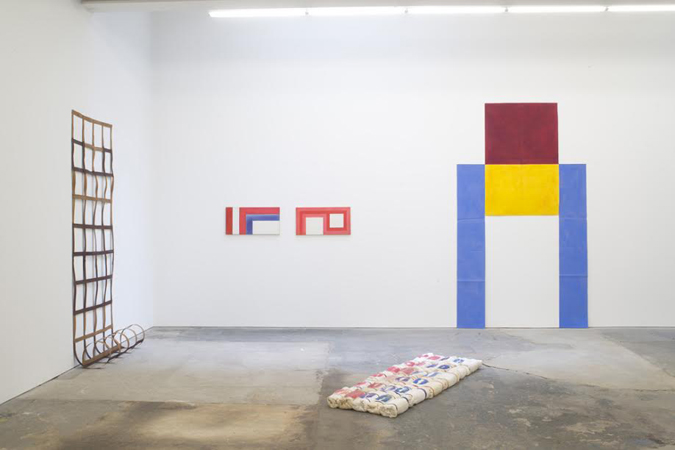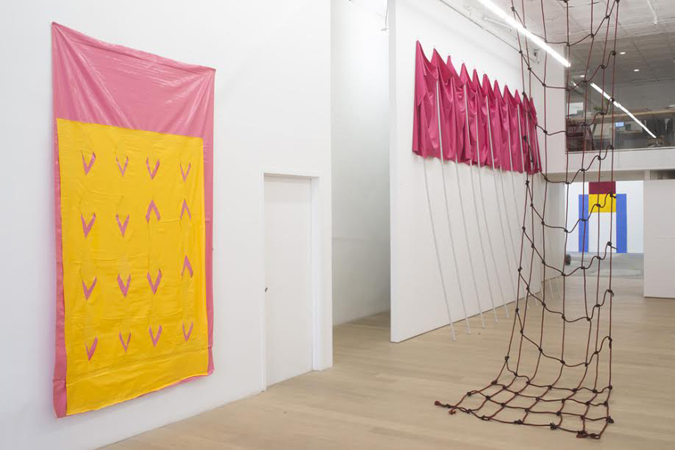Supports / Surfaces by Nick Van Zanten
The French Supports/Surfaces painters of the 1970’s have been woefully overlooked in America, which is especially remarkable given how many young abstract painters seem to be following in their footsteps today. The appropriately named Supports/Surfaces at Canada on Broome St through July 20 aims to fix this. Works hang from the ceiling and sit on the floor in Carl Andre-like grids; paintings are made on dishrags and out of rope knotted into nets. It is a brightly colored, energetic show, where no artist has made any attempt to hide the trace of his gesture. It argues as much for the celebration of the handmade as for the embrace of everything contingently flat as a support for a painting. These artists share a rejection of those elements of painting that demand institutional attention. Perhaps they have been overlooked because they do not want to fit into the gallery or museum and were designed not to be saleable. Seeing this work transposed into a white cube makes the viewer question the necessity of the pure white walls while also bringing the work into a physical context where its similarities to contemporary American painting are undeniable. New painting like that currently on view at, for example, David Zwirner, where pieces similarly descend from the ceiling and are made out of anything, is Support/Surfaces without the hostility to the establishment; a repetition of this Marxist reaction to the tragedy of May 1968 as decorative, capitalist farce. All the more reason why this show should appear now, before these artists can be whitewashed by their contemporary heirs who may be more likely to be embraced by art history.
The Supports/Surfaces artists were outspoken leftists even amongst the May 1968 crowd that gave us such artists as Daniel Buren. Louis Cane, featured prominently in the show, saw his work, with its ample evidence of his own touch, as being in opposition to Buren’s. His best piece in the show is reminiscent of a Buren taken to extremes, the trademark vertical stripes here made with many stamps of his name. The difference between his signature and Buren’s is minor, one of degree, but the semiotic shift between a visual sign slipped into abstraction and Cane’s indexical practice is telling. These painters liked to be completely honest about what they were doing and what painting is. Claude Viallat’s two rope pieces are unpainted except where he knotted the rope, breaking apart and creating anew the way in which paint on a painting records the site of the artist’s hand – here it may not be a painting, and the correlation may be tautological with the knots, but it is proof of the same principal. This is what separates the Supports/Surfaces artists from Simon Hantaï or Steven Parrino, who both were equally willing to toss the canvas around but did not use the paint as a mark of the artist’s gesture.
It is strange to see these paintings-as-objects-in-the-world as paintings in a gallery. It works because we have become so accustomed to work like this appearing in places like this; and it is true that as the work claims to be painting it should be able to appear in galleries. Yet much Supports/Surfaces activity did not take place in the gallery but out in the world, in nature and in the city. On the inside cover of the accompanying catalog is a photograph of Claude Viallet at a beach holding up what looks like a fisher’s net but may be painting. No clarification is given, yet here is the ambiguity of Supports/Surfaces work when perfectly fulfilled. Is it a net, a painting, or both? It can be both, whether by the seashore or in a gallery. Yet this is not simply a matter of readymades, of anything flat being valid as a painting. Patrick Saytour’s Deployed, a long, unpainted pink banner propped up by many poles against the walls of the gallery, is shown in the catalog in the street, leaning against a stone wall. The title may be a reference to the change the physical object undergoes when taken out of storage and “hung,” as it were, going from being a set of poles and a bolt of fabric to being a painting; but in the street it has a greater meaning, a painting deployed as direct action in public instead of at home in a gallery, where only people who go looking for it will find it.
Despite the comparison to recent painting, the works in the show feel very much of their time. The more straightforward work fails to argue that it is anything other than mid-century, Ab-Ex inspired abstraction, and the colors, both those that the artists used and those in the found materials they painted on, date the work. Perhaps as a hold-over from mid-century modernism, the grid is a ubiquitous, from the numerous net pieces to Jean-Pierre Pincemin’s Carrés Collés, a grid of smaller paintings, material freedom is countered by execution towards formal order. This is not to say that it matches the similarly uptight freedom of Minimalism, however, and the 1970’s-ness of the color is a key part of this, as it is the color of banal 70’s design. With the exception of Mark Devade’s geometric abstractions on stretched canvas, the work never approaches formalism straight-on, but rather seeks to show the parts and labor that come together to make formal abstraction, and to pull away the curtain to show the artist’s hand and the chosen surface as being nothing special.

On the one hand, the museum-like presentation feels like a just presentation of work that been overlooked for too long; yet it also it struck me that the meaning of the work is itself lost by being shown in this manner. The dearth of critical comment in reviews and in the exhibition materials only added to this feeling (Rafael Rubinstein’s article from a decade ago, which may be found on artcritical, thankfully fills the gap). This conflict is at the heart of the Supports/Surfaces movement, and is what gives it strength; it is painting and belongs in a devotional space with minimal distraction; and it is quotidian and organic and belongs, ephemeral and contingent, out in the world, where it may or may not be noticed. One hopes that artists today will take from the show not only the virtues of transparency but also an understanding that modest painting is just that.
Photos courtesy of Canada Gallery






